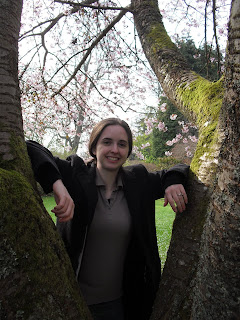A couple weeks ago, Nana and I headed up to
Perth for yet another day of nerding about.
Perth is the adminstrative seat of
Perth and Kinross, a council district made up of the traditional counties of sprawling
Perthshire and tiny
Kinross-shire. Perthshire straddles the
Highland Line, so the county is low and fertile in the east, rugged and rocky in the west. Perth itself sits on the
River Tay at the furthest point upriver you can reliably sail, and historically it served as an important port for the area, with trade connections reaching down the east coast of Britain and all the way to the Continent.
Today, Perth is a sleepy town, dependent mostly on tourism, as its location makes it a popular base for exploring the southeastern part of the Highlands.
Perth itself, however, is not without its attractions, foremost among which is a charming local museum. The
Perth Museum and Art Gallery houses several interesting collections. The largest single exhibit we visited was of a collection of archaeological finds from in and around Perth, focusing mostly on everyday life in the medieval town. Of course, the exhibit also had the obligatory opportunity for playing dress-up . . . this seems to be a British thing!
An adjacent exhibit details local arts and crafts . . .
. . . including a life-sized sheep made of glass tubes (of course).
They also had a cabinet of
communion tokens from the Church of Scotland and its (many, many, many) offshoots around the world . . . including Pittsburgh!
Communion tokens are an odd little quirk of many Protestant congregations. Communion was a big occasion, usually annual, and before partaking churchgoers had to pass a religious test (of orthodoxy, loyalty, etc) and had to present their tokens for admission to the communion ceremony. Often, tokens required a small donation, and were thus also used as fundraisers for their respective churches. The practice was at its peak in the 19th century.
After a couple hours in the museum, Nana and I stumbled upon a street fair in Perth's main pedestrian shopping district--a perfect opportunity for lunch!
And it seems British multiculturalism has reached as far as Perthshire these days: after walking past huge vats of paella and Chinese noodles . . .
. . . we settled on a Polish stew of beef, sausage, and cabbage for the main course . . .
. . . and a selection of Turkish pastries for dessert.
Yum!
 Snow on Holyrood Park, Edinburgh, January 2010
Snow on Holyrood Park, Edinburgh, January 2010 View from Mar's Wark, Stirling, December 2009
View from Mar's Wark, Stirling, December 2009 Mountains, possibly Trossachs, from Stirling, December 2009
Mountains, possibly Trossachs, from Stirling, December 2009 Sunset from Stirling Castle, December 2009
Sunset from Stirling Castle, December 2009
 Meadows park, Edinburgh, May 2010.
Meadows park, Edinburgh, May 2010.


 Rainbow over Inverness, September '09
Rainbow over Inverness, September '09

 Hope you enjoyed!
Hope you enjoyed!

























